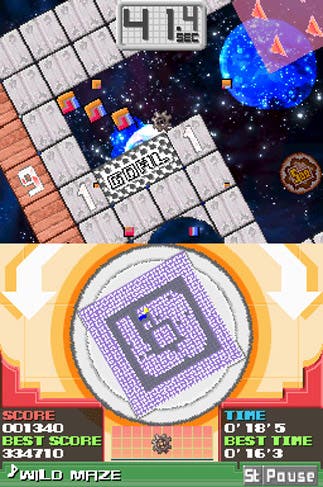DS Game Roundup
Monsters, mazes and more that you've never heard about.
Labyrinth
Better known as Mawashite Koron (which is probably saying something), Labyrinth might jingle your mental jangle a bit more if we referred to it as Cameltry - to which this DS effort is a direct sequel. Those of you who remember Taito's late '80s arcade game or the subsequent Super Nintendo release will be perfectly at home here, rotating mazes around a little ball in the centre of the screen so that it eventually falls into the goal.
The DS version introduces touch-screen controls and an overhead map, but don't expect to find much use for either - the stylus often slips out of the areas on the screen that accept control input, rendering the extra precision it can allow rather moot, while the map is a mess of squiggles that doesn't really help at all. Fortunately you can get on fine without either feature. The d-pad left and right buttons, the shoulder buttons, or the face buttons' Y and A all happily rotate the screen instead, depending on which you want to use, while the X button activates the ball's "gyro" function, revving it up like Sonic the Hedgehog's spinball attack so that it can cut across conveyor belts and bust through blocks.

This is something you'll spend a lot of time doing, but while speed is critical to beating the countdown you're up against, with so many steel bumpers and other obstacles to avoid the real challenge in Labyrinth is in controlling your ball's movement in tight spaces. Rather like PS2/PSP title Mercury Meltdown, you can find yourself hung up on things unless you pay close attention, and with plenty of time-sapping blocks waiting to steal your precious seconds away, you have to be - in deference to the SNES version's US title - fairly On The Ball.
The levels themselves are usually pretty easy to find your way through, although once you conquer the first four sets of courses and unlock the trickier sections you might find yourself getting lost here and there. You can at least retry as many times as you like, although the need to memorise sections by rote isn't particularly welcome. More so is the four-player single-cart competitive mode, and there's also the option to customise your ball - although whether you'll bother when the result is so small on the screen is questionable.
Sadly the difficulty level is all over the place, with some of the unlockable "Maniac" levels easier than the opening ones, and although it's nice to see the game in English, we find ourselves using the term rather lightly. "When a ball is slid into the Gyro Area, the gyro depends on the ball. Furthermore, when the timing of sliding is good, the Gyro will power up." Amusing, yes, but not very helpful when you face a level where you need to increase the ball's strength through evenly timed bashes of X in order to bust through certain grey blocks, and neither the game or manual come close to explaining this.
There's still fun to be had, but Labyrinth hasn't really moved on in the nearly-20 years since it rose to fleeting prominence, and is probably best left alone until it's fallen off the budget games shelf into the bargain bin.
